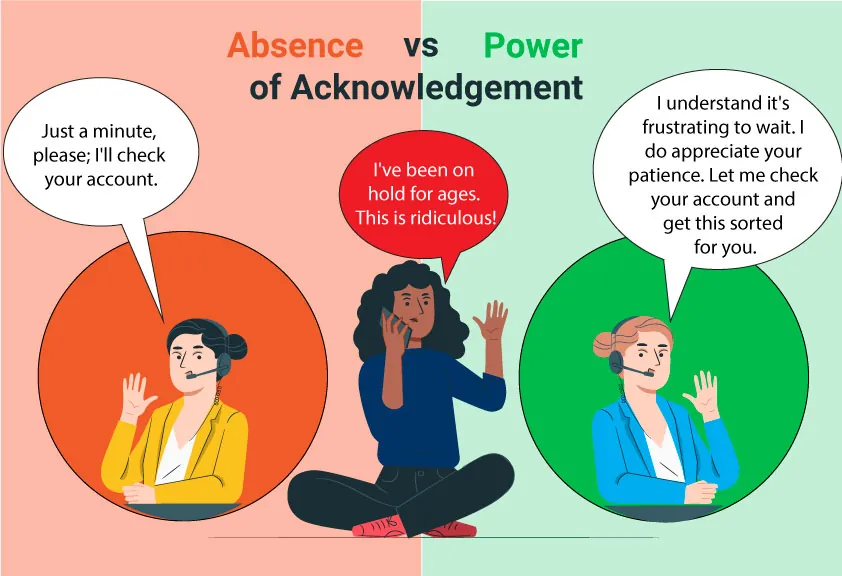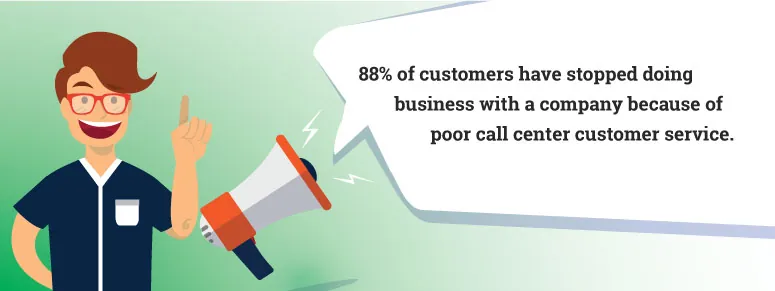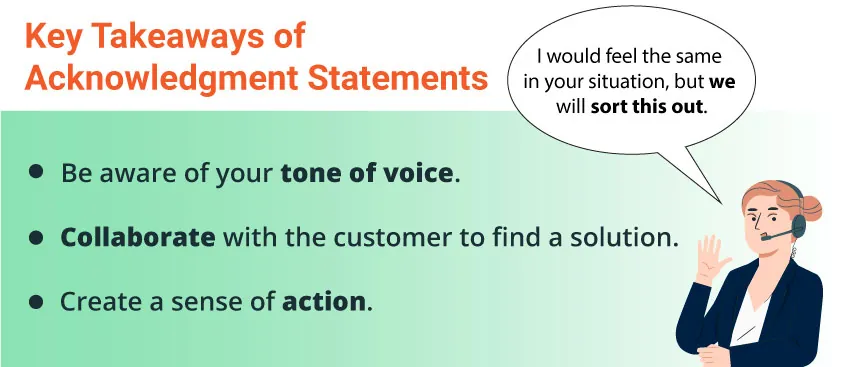Acknowledgment statements are an often overlooked technique in the call center industry. However, the impact of a well-crafted acknowledgment statement can make a phenomenal difference in a customer's customer service experience. Picture this: a customer calls a call center, frustrated and seeking assistance with an issue. Notice the difference between these two scenarios:
Scenario 1: The Absence of Acknowledgment
Customer: "I've been on hold for ages. This is ridiculous!"
Agent: "Just a minute, please; I'll check your account."
In this instance, the agent dives straight into the task at hand, seemingly disregarding the customer's frustration. The interaction lacks a human touch, and the customer might feel unheard, potentially escalating the tension.
Scenario 2: The Power of Acknowledgment
Customer: "I've been on hold for ages. This is ridiculous!"
Agent: "I understand it's frustrating to wait. I do appreciate your patience. Let me check your account and get this sorted for you."
In this scenario, the agent starts with an acknowledgment statement, recognizing the customer's frustration. This simple act of empathy sets the stage for a more positive interaction. The customer feels acknowledged, and the agent establishes a connection by conveying understanding.

Positive acknowledgment statements are not mere niceties; they are potent tools that empower call center agents to take ownership of a call, turning challenges into opportunities for resolution. These statements diffuse tension and create a foundation for a collaborative exchange.
Building customer rapport is a cornerstone of effective customer service, and acknowledgment statements are the cornerstone of rapport building. They show customers their feelings are recognized and valid, creating a more cooperative atmosphere. This connection, grounded in empathy, lays the groundwork for a smoother resolution process.
Yet, it's crucial to remember that the impact of acknowledgment extends deeper than what is said; how something is said is just as important, if not more so, than what is said. The phrase "I understand your frustration" can come across as robotic or insincere if spoken with the wrong tone of voice.
A call center agent is the voice of a company. What they say and how they say it can make or break a customer relationship. For example, SQM Research shows that 95% of customers will continue to do business with a company because they have experienced great CX interacting with an agent. Conversely, 88% of customers have stopped doing business with a company because of poor call center customer service.

What Is an Acknowledgment Statement?
An acknowledgment statement is used to acknowledge a customer's concerns, feelings, or issues. It typically involves expressing empathy, understanding, or gratitude and serves to validate the customer's experience.
When a customer has an issue with a company, they want the company to be aware of it. For this to happen, the agent who represents the company needs to acknowledge that they have heard and understand the customer's issue.
For example:
"I completely understand your frustration, and I appreciate your patience. I'll do my best to resolve this for you as quickly as possible."
"I'm sorry to hear about your experience, and I appreciate you bringing this to our attention. We are committed to making things right for you."
In both examples, the agent is acknowledging that the customer has had a negative experience, and they are turning the negative situation into a positive by expressing appreciation or gratitude and letting the customer know that they will do their best to rectify the situation.
Why Use Acknowledgment Statements?
Productive conversations result from both parties understanding the other's viewpoint and communicating openly, whether it's about long hold times, a faulty product, or another issue.
Acknowledgment statements are a way to demonstrate understanding and find common ground with the customer. Agents don't need to agree with everything a customer says to foster a connection – they can instead selectively agree with the customer.
For example, let's consider a scenario where a customer is angry about something outside an agent's or company's control. The agent doesn't need to take ownership; however, they can still relate to the agent's emotion by saying, "I would be frustrated if I were in your shoes, too."
Examples of Acknowledgment Statements
1. "I realize this situation is difficult, but let's try and find a solution."
This statement demonstrates empathy by acknowledging the difficulty of the situation and immediately offers a proactive approach toward finding a solution. It sets a positive tone for problem-solving and collaboration.
2. "What you have gone through is equally unacceptable to us as it is to you."
This acknowledgment aligns the company with the customer, emphasizing shared values and concerns. It validates the customer's experience, building a sense of understanding and unity.
This is effective when a customer has experienced a significant problem or inconvenience. However, in minor or routine situations, this statement might seem overly dramatic and could escalate a situation unnecessarily.
3. "Now that I know what is happening, I will try my best to resolve it for you."
This statement combines acknowledgment with a commitment to action. Ensuring the customer of the agent's dedication to resolving the issue instills confidence and emphasizes proactive customer service.
This example is ideal for situations where the agent has just gathered information about the customer's issue and wants to convey immediate action and commitment to resolution.
4. "I would feel the same in your situation, but we will sort this out…"
This acknowledgment empathizes with the customer, creating a connection by expressing shared emotions. It reassures the customer that the issue will be addressed, promoting a collaborative problem-solving atmosphere.
This statement would be effective when the customer expresses strong emotions or frustration. However, in cases where the customer is more focused on facts and solutions rather than emotional connection, this statement might be perceived as overly empathetic.
5. "I understand how frustrating it can be when this happens. Let's see how we can help…"
By acknowledging the customer's frustration, this statement shows empathy and immediately transitions to a problem-solving mindset. It invites collaboration, demonstrating a customer-centric approach.
6. "I can only imagine how upsetting it is to have this problem with your product."
Expressing understanding and sympathy, this acknowledgment validates the customer's emotions. It creates a human connection, emphasizing that the agent acknowledges the issue's impact on the customer.
7. "Your problem with the product sounds like it's been quite annoying for you. Let's see what we can do to change that."
This statement not only acknowledges the customer's frustration but also emphasizes a collaborative effort to address the issue. It shows a commitment to finding a solution and turning the situation around.
This example might be less effective when the customer is already calm and simply seeking information, as it could introduce unnecessary emotional emphasis. It's important to pay attention to the customer's tone of voice and choice of words to avoid making assumptions about their emotional state.
8. "Thank you for getting in touch about this problem with your product. It helps us to be aware of these things so we can fix them as quickly as possible."
Expressing gratitude for the customer's communication, this acknowledgment highlights the importance of customer feedback. It demonstrates a proactive approach to problem-solving and a commitment to continuous improvement.
This statement should be avoided if the customer is calling about a recurring issue because it will come across as insincere and could worsen the situation.
Key Takeaways for Acknowledgment Statements

- Be aware of your tone of voice
According to a study conducted by a UCLA professor, Albert Mehrabian, an individual's opinion on whether a person is likable is influenced 7% by verbal language, 38% by tone of voice, and 55% by body language/facial expressions. Therefore, an agent's tone of voice is extremely important for improving customer experience.
SQM's research shows that an agent's tone of voice is highly correlated with the acceptance rate when conducting post-call surveys. In fact, a customer is almost twice as likely to stay on the line and answer the customer satisfaction survey questions when the agent uses a positive and upbeat tone rather than a lower tone.
No matter whether you effectively use acknowledgment statements or not, if your tone of voice comes across as bored, rude, or disengaged, you will not establish a connection with the customer. So, pay attention to what you say and how you say it.
- Collaborate with the customer to find a solution
Although it is crucial to take personal responsibility for issues that arise as a direct result of the agent or company's doing, it is also important to create a notion of teamwork with the customer. This way, the customer feels included in the problem-solving process and views the agent more favorably.
Using "we," as in the customer and agent, not the agent and the company, also demonstrates a commitment to working together, which fosters rapport and connection.
- Create a sense of action
Merely acknowledging the customer's frustration or issue without connecting it to an action is essentially a gesture of sympathy. Therefore, after the agent acknowledges the issue, they should also provide a clear plan for the next course of action.
By creating a sense of action, the agent can guide the customer through the resolution process and impart a sense of urgency. This makes the customer feel like the agent, and in turn, the company understands the matter's significance. In this way, the acknowledgment transforms into a proactive step, reinforcing the commitment to FCR.
